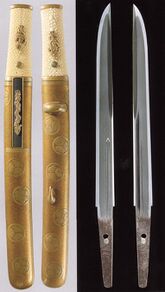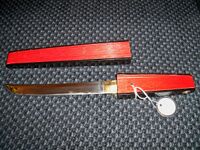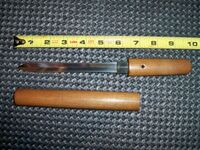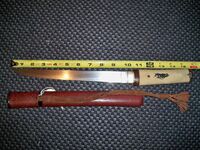Engineering:Tantō
| Script error: The function "transl" does not exist. | |
|---|---|
 Script error: The function "transl" does not exist. with signature (Script error: The function "transl" does not exist.) of Shintōgo Kunimitsu. Complete Script error: The function "transl" does not exist.-style Script error: The function "transl" does not exist. (mountings) and bare blade. Kamakura Period, 14th century. Important Cultural Property. | |
| Type | Japanese sword |
| Production history | |
| Produced | Heian period (794–1185) to present |
| Specifications | |
| Blade length | approx. 15–30 cm (5.9–11.8 in) |
| Blade type | Double or single edged, straight bladed |
A Lua error in Module:Lang/utilities at line 268: attempt to call field '_transl' (a nil value).[1] is one of the traditionally made Japanese swords[2] (Script error: The function "transl" does not exist.)[3][4] that were worn by the samurai class of feudal Japan. The Script error: The function "transl" does not exist. dates to the Heian period, when it was mainly used as a weapon but evolved in design over the years to become more ornate. Script error: The function "transl" does not exist. were used in traditional martial arts (Script error: The function "transl" does not exist.). The term has seen a resurgence in the West since the 1980s as a point style of modern tactical knives, designed for piercing or stabbing.
Description
The Script error: The function "transl" does not exist. is a single or double edged dagger with a length between 15–30 cm (5.9–11.8 in) (1 Japanese Script error: The function "transl" does not exist.). The Script error: The function "transl" does not exist. was designed primarily as a stabbing weapon, but the edge can be used for slashing as well. Script error: The function "transl" does not exist. are generally forged in the hira-zukuri (平造) style (without a ridgeline),[1][5] meaning that their sides have no ridge line and are nearly flat, unlike the shinogi-zukuri (鎬造) structure of a katana. Some Script error: The function "transl" does not exist. have particularly thick cross-sections for armor-piercing duty, and are called Script error: The function "transl" does not exist..
Script error: The function "transl" does not exist. were mostly carried by samurai; commoners did not generally wear them. Women sometimes carried a small Script error: The function "transl" does not exist. called a Script error: The function "transl" does not exist.[6] in their Script error: The function "transl" does not exist., primarily for self-defense. Script error: The function "transl" does not exist. were sometimes worn as the shōtō (小刀) in place of a Script error: The function "transl" does not exist. in a Script error: The function "transl" does not exist.,[7][8] especially on the battlefield. Before the advent of the Script error: The function "transl" does not exist. combination, it was common for a samurai to carry a Script error: The function "transl" does not exist. and a Script error: The function "transl" does not exist. as opposed to a katana and a Script error: The function "transl" does not exist..[7]
It has been noted that the Script error: The function "transl" does not exist. would be paired with a Script error: The function "transl" does not exist. and later the katana would be paired with another shorter katana. With the advent of the katana, the Script error: The function "transl" does not exist. was eventually chosen by samurai as the short sword of choice over the Script error: The function "transl" does not exist.. Kanzan Satō, in his book The Japanese Sword, notes that there did not seem to be any particular need for the Script error: The function "transl" does not exist., and suggests that the Script error: The function "transl" does not exist. may have become more popular than the Script error: The function "transl" does not exist. due to the Script error: The function "transl" does not exist. being more suited for indoor fighting. He mentions the custom of leaving the katana at the door of a castle or palace when entering while continuing to wear the Script error: The function "transl" does not exist. inside.[9]
History of Script error: The function "transl" does not exist. in Japan
The production of swords in Japan is divided into specific time periods:
- Jōkotō (ancient swords, until around 900 AD)
- Kotō (old swords from around 900–1596)
- Shintō (new swords 1596–1780)
- Shinshintō (new new swords 1781–1876)
- Gendaitō (modern swords 1876–1945)[10]
- Shinsakutō (newly made swords 1953–present)[11]
Heian to Muromachi periods

The Script error: The function "transl" does not exist. was invented partway through the Heian period. With the beginning of the Kamakura period, Script error: The function "transl" does not exist. were forged to be more aesthetically pleasing, and Script error: The function "transl" does not exist. and Script error: The function "transl" does not exist. became the most popular styles. Near the middle of the Kamakura period, more Script error: The function "transl" does not exist. artisans were seen, increasing the abundance of the weapon, and the Script error: The function "transl" does not exist. style became prevalent in the cities of Kyoto and Yamato. Because of the style introduced by the Script error: The function "transl" does not exist. in the late Kamakura period, Script error: The function "transl" does not exist. began to be forged longer and wider. The introduction of the Hachiman faith became visible in the carvings in the hilts around this time. The Script error: The function "transl" does not exist. (line of temper) is similar to that of the Script error: The function "transl" does not exist., except for the absence of Script error: The function "transl" does not exist., which is Script error: The function "transl" does not exist. and Script error: The function "transl" does not exist.. Script error: The function "transl" does not exist. and Script error: The function "transl" does not exist. are found to have taken its place.
During the era of the Northern and Southern Courts, the Script error: The function "transl" does not exist. were forged to be up to 40 centimetres (16 in) in length, as opposed to the normal one Script error: The function "transl" does not exist. (about 30 cm (12 in)) length. The blades became thinner between the Script error: The function "transl" does not exist. and the Script error: The function "transl" does not exist., and wider between the Script error: The function "transl" does not exist. and Script error: The function "transl" does not exist.. At this point in time, two styles of Script error: The function "transl" does not exist. were prevalent: the older style, which was subtle and artistic, and the newer, more popular style. With the beginning of the Muromachi period, constant fighting caused the mass production of blades, meaning that with higher demand, lower-quality blades were manufactured. Blades that were custom-forged still were of exceptional quality, but the average blade suffered greatly. As the end of the period neared, the average blade narrowed and the curvature shallowed.[12]
Katana originate from sasuga (刺刀), a kind of Script error: The function "transl" does not exist. used by lower-ranking samurai who fought on foot in the Kamakura period. Their main weapon was a long Script error: The function "transl" does not exist., with the Script error: The function "transl" does not exist. as a spare weapon. In the Nanboku-chō period, which corresponds to the early Muromachi period, long weapons such as Script error: The function "transl" does not exist. were popular, and along with this, the Script error: The function "transl" does not exist. lengthened, taking its form as the katana.[13][14]
Momoyama to the early Edo period
Approximately 250 years of peace accompanied the unification of Japan, in which there was little need for blades. In this period, both the katana and Script error: The function "transl" does not exist. were invented, taking the place of the Script error: The function "transl" does not exist. and Script error: The function "transl" does not exist. as the most-used pair of weapons, and the number of Script error: The function "transl" does not exist. forged was severely decreased.[15] Since this period, Script error: The function "transl" does not exist. have often been carved with splendid decorations. Of the Script error: The function "transl" does not exist. and Script error: The function "transl" does not exist. forged during this period, three masterpieces are called the Lua error in Module:Lang/utilities at line 268: attempt to call field '_transl' (a nil value)..[16]
Late Edo period

There were still a few Script error: The function "transl" does not exist. being forged during the late Edo period, and the ones that were forged reflected the work of the Kamakura, Nambokucho, or Muromachi eras. Suishinshi Masahide was a main contributor towards the forging of Script error: The function "transl" does not exist. during this age.[15] There were now only Script error: The function "transl" does not exist. predating the Edo period being used in combat; Script error: The function "transl" does not exist. forged during the late Edo period were not combative weapons.
Meiji to present
Many Script error: The function "transl" does not exist. were forged before World War II, due to the restoration of the Emperor to power. Members of the Imperial Court began wearing the set of Script error: The function "transl" does not exist. and Script error: The function "transl" does not exist. once more, and the number of Script error: The function "transl" does not exist. in existence increased dramatically. After World War II, a restriction on sword forging caused Script error: The function "transl" does not exist. manufacture to fall drastically.[17] American and European interest in Japanese martial arts since the war created a demand for the Script error: The function "transl" does not exist. outside Japan from the 1960s through the present time.[18]
Types of Script error: The function "transl" does not exist.
Blade types

- Hira (平): A very common Script error: The function "transl" does not exist. form with no Script error: The function "transl" does not exist., the edge bevels reaching all the way from the edge (Script error: The function "transl" does not exist.) to the back (Script error: The function "transl" does not exist.) with no separate flats in between, creating an almost triangular cross-section (the back is ridged, as on most other blade forms, so the cross-section is actually an extremely asymmetrical diamond shape; on Script error: The function "transl" does not exist. blades it is hexagonal). It is extremely common due to the simplicity of its design.
- Shinogi (鎬): This is the most common type of blade geometry for long swords, but Script error: The function "transl" does not exist. made in this form are very rare, usually created from cut-down blades when a longer sword has been broken. Script error: The function "transl" does not exist. means the central ridge that runs along the length of the blade between the edge bevels and the body of the blade.
- Script error: The function "transl" does not exist.: Script error: The function "transl" does not exist. feature an extremely long Script error: The function "transl" does not exist. type point, over half the blade's length.
- Shōbu (菖蒲): A common blade type that is very similar to the Script error: The function "transl" does not exist., except that it lacks a Script error: The function "transl" does not exist., the distinct angle between the long cutting edge and the point section, and instead the edge curves smoothly and uninterrupted into the point.
- Unokubi (鵜首): An uncommon Script error: The function "transl" does not exist. style akin to the Script error: The function "transl" does not exist., with a back that grows abruptly thinner around the middle of the blade; however, the Script error: The function "transl" does not exist. regains its thickness just before the point. There is normally a short, wide groove extending to the midway point on the blade.
- Script error: The function "transl" does not exist.: These Script error: The function "transl" does not exist. were shaped in the Script error: The function "transl" does not exist. or Script error: The function "transl" does not exist. style, but from about half way to the tip the back edge was sharpened though this second edge was not particularly sharp. They had a groove running halfway up the blade and were similar to the Script error: The function "transl" does not exist.-style Script error: The function "transl" does not exist..
- Kissaki-moroha (切先両刃): A rare blade type with a double-edged point. Unlike the later Script error: The function "transl" does not exist. the tip had a distinct shape unlike any other Script error: The function "transl" does not exist.: the back edge would curve slightly downwards so that the point was lower than the back of the blade whereas other Script error: The function "transl" does not exist. had the point in line with the back of the blade. Often they had a wide groove in the base half. The most well known historical blade of this type is the Script error: The function "transl" does not exist. Kogarasu Maru, "Little Crow", one of the National Treasures of Japan.
- Moroha (両刃): A rare, double-edged Script error: The function "transl" does not exist. type that has a diamond-shaped cross-section. The blade tapers to a point and contains a Script error: The function "transl" does not exist. that runs to the point.
- Yoroi tōshi (鎧通し, or Script error: The function "transl" does not exist.): Script error: The function "transl" does not exist. that have particularly thick cross-sections for armor-piercing duty.
- Katakiriha (片切刃): An asymmetric Script error: The function "transl" does not exist. form, sharpened only on one side to create a chisel-shaped cross-section.
- Kubikiri (首切り): A very rare type; the sharpened blade is on the inside curve rather than the outside. It has no sharpened point, making it difficult to use in battle and enshrouding the weapon in mystery. Script error: The function "transl" does not exist. means 'head cutter'. According to one myth, they were carried by attendants of samurai for cutting off the heads of fallen enemies. There are other speculations existing about the Script error: The function "transl" does not exist.'s possible uses. Perhaps they were used by doctors or carried by high-ranking officials as a badge is worn today. They could also have been used for cutting charcoal or incense, or used as an artistic tool for pruning bonsai trees.[19]
- Hōchōgata (包丁形): A Script error: The function "transl" does not exist. form that is commonly described as a short, wide, Script error: The function "transl" does not exist.. The Script error: The function "transl" does not exist. ('kitchen knife-shaped') was one of the blade type that the legendary swordsmith Masamune favored.
Mountings (Script error: The function "transl" does not exist.)
- Aikuchi (合口): The Script error: The function "transl" does not exist. is a Script error: The function "transl" does not exist. where the Script error: The function "transl" does not exist. is flush with the mouth of the sheath. There is no handguard. Script error: The function "transl" does not exist. normally have plain wooden hilts, and many forms of Script error: The function "transl" does not exist. have Script error: The function "transl" does not exist. that are made from animal horns.
- Script error: The function "transl" does not exist.: The Script error: The function "transl" does not exist. is a Script error: The function "transl" does not exist. that features a small handguard.
Other Script error: The function "transl" does not exist.
- Script error: The function "transl" does not exist.: The Script error: The function "transl" does not exist. (also Script error: The function "transl" does not exist. or Script error: The function "transl" does not exist.) is a generally short Script error: The function "transl" does not exist. that is commonly carried in Script error: The function "transl" does not exist. or Script error: The function "transl" does not exist. mounts. It was useful for self-defense indoors where the long katana and intermediate Script error: The function "transl" does not exist. were inconvenient. Women carried them in the obi for self-defense and rarely for Script error: The function "transl" does not exist. (ritual suicide). A woman received a Script error: The function "transl" does not exist. as part of her wedding gifts.
- Fan Script error: The function "transl" does not exist.: The fan Script error: The function "transl" does not exist. is a common Script error: The function "transl" does not exist. with a blade entirely concealed within a fan-shaped scabbard. The blade was usually low quality, as this Script error: The function "transl" does not exist. was not designed to be a display piece, but rather a concealed weapon for self-defense.
- Script error: The function "transl" does not exist.: Japanese spearheads were often altered so that it became possible to mount them as Script error: The function "transl" does not exist.. Unlike most blades, Script error: The function "transl" does not exist. had triangular cross-sections.
- Modern Script error: The function "transl" does not exist.: Modern tactical knives have been made by knife makers Bob Lum, Phill Hartsfield, Ernest Emerson, Allen Elishewitz, Bob Terzuola, Strider Knives, Harold J. "Kit" Carson, Benchmade, Camillus Cutlery Company, Spyderco, Severtech, Ka-Bar, SOG Knives, Columbia River Knife & Tool, and Cold Steel.[20] These "American Script error: The function "transl" does not exist." designs which are often folding knives, feature a thick spine on the blade that goes from the tang to the tip for increased tip strength.[21] The handle shape may be altered slightly to provide better ergonomics.[18]
Use in martial arts
Script error: The function "transl" does not exist. with blunt wooden or blunt plastic blades are used to practice martial arts. Versions with a blunt metal blade are used in more advanced training and in demonstrations. Martial arts that employ the Script error: The function "transl" does not exist. include:
- Aikido
- Aikijutsu
- Jujutsu
- Wadō-ryū (both Script error: The function "transl" does not exist. and katana)
- Koryu bujutsu
- Ninjutsu
- Shorinji Kempo
- Modern Arnis (taking place of dagger)
Popular culture
- Teenage Mutant Ninja Turtles features Script error: The function "transl" does not exist. knives used by April O'Neil, Leonardo, and Splinter in the 2012 version, and also by the Shredder in the 1990 version and Karai in the 2003 version.
Gallery
See also
- List of daggers
- Fighting knife
- Japanese sword
References
- ↑ 1.0 1.1 The samurai sword: a handbook, John M. Yumoto, Tuttle Publishing, 1989 P.47
- ↑ Handbook to life in medieval and early modern Japan, William E. Deal, Oxford University Press US, 2007 P.161
- ↑ The Development of Controversies: From the Early Modern Period to Online Discussion Forums, Volume 91 of Linguistic Insights. Studies in Language and Communication, Author Manouchehr Moshtagh Khorasani, Publisher Peter Lang, 2008, ISBN:3-03911-711-4 p.150
- ↑ The Complete Idiot's Guide to World Mythology, Complete Idiot's Guides, Authors Evans Lansing Smith, Nathan Robert Brown, Publisher Penguin, 2008, ISBN:1-59257-764-4 P.144
- ↑ Styles in the Shape of Blades
- ↑ Kaiken
- ↑ 7.0 7.1 The Japanese Sword, Kanzan Satō, Kodansha International, 1983 P.68
- ↑ Shotokan's Secret: The Hidden Truth Behind Karate's Fighting Origins, Bruce D. Clayton, Black Belt Communications, 2004 P106
- ↑ The Japanese Sword, Kanzan Satō, Kodansha International, 1983 P.68
- ↑ Clive Sinclaire (1 November 2004). Samurai: The Weapons and Spirit of the Japanese Warrior. Lyons Press. pp. 40–58. ISBN 978-1-59228-720-8. https://books.google.com/books?id=IQ3FAZG94ZsC&pg=PA40.
- ↑ トム岸田 (24 September 2004). 靖国刀. Kodansha International. p. 42. ISBN 978-4-7700-2754-2. https://books.google.com/books?id=z6oB6eFRjZkC&pg=PA42.
- ↑ Satō, Kanzan (1983). Joe Earle. ed. The Japanese Sword; Volume 12 of Japanese arts library. Kodansha International. pp. 62–64. ISBN 978-0-87011-562-2.
- ↑ 歴史人 September 2020. p40. ASIN B08DGRWN98
- ↑ List of terms related to Japanese swords "Sasuga". Nagoya Japanese Sword Museum Touken World.
- ↑ 15.0 15.1 Satō (1983) p. 68
- ↑ 崇高なる造形-日本刀 名刀と名作から識る武士の美学-. Bijutsu techō
- ↑ Sinclaire, Clive (2004). Samurai: The Weapons and Spirit of the Japanese Warrior. Globe Pequot. p. 59. ISBN 978-1-59228-720-8. https://archive.org/details/samuraiweaponssp0000sinc/page/59.
- ↑ 18.0 18.1 Steele, David (1981). "Japanese Daggers". Black Belt (Black Belt, Inc.) 19 (2): 55–60.
- ↑ "Unusual tantō". http://home.earthlink.net/~steinrl/unji.htm.
- ↑ Pacella, Gerard (2002). 100 Legendary Knives. Krause Publications. pp. 124–126. ISBN 0-87349-417-2.
- ↑ "American Tanto - Blade Geometry Knife FAQ". faq.customtacticals.com. http://faq.customtacticals.com/geometry/shape_amtanto.php.
External links
 |















